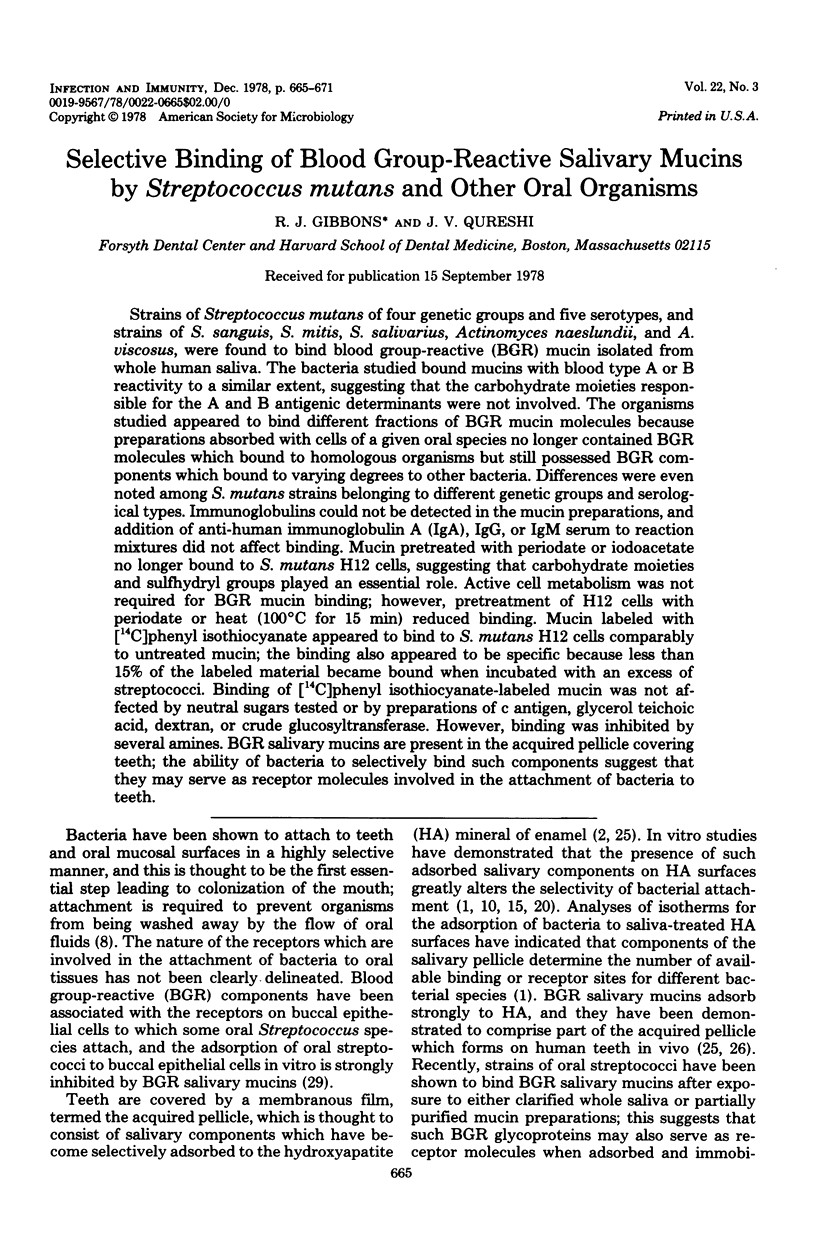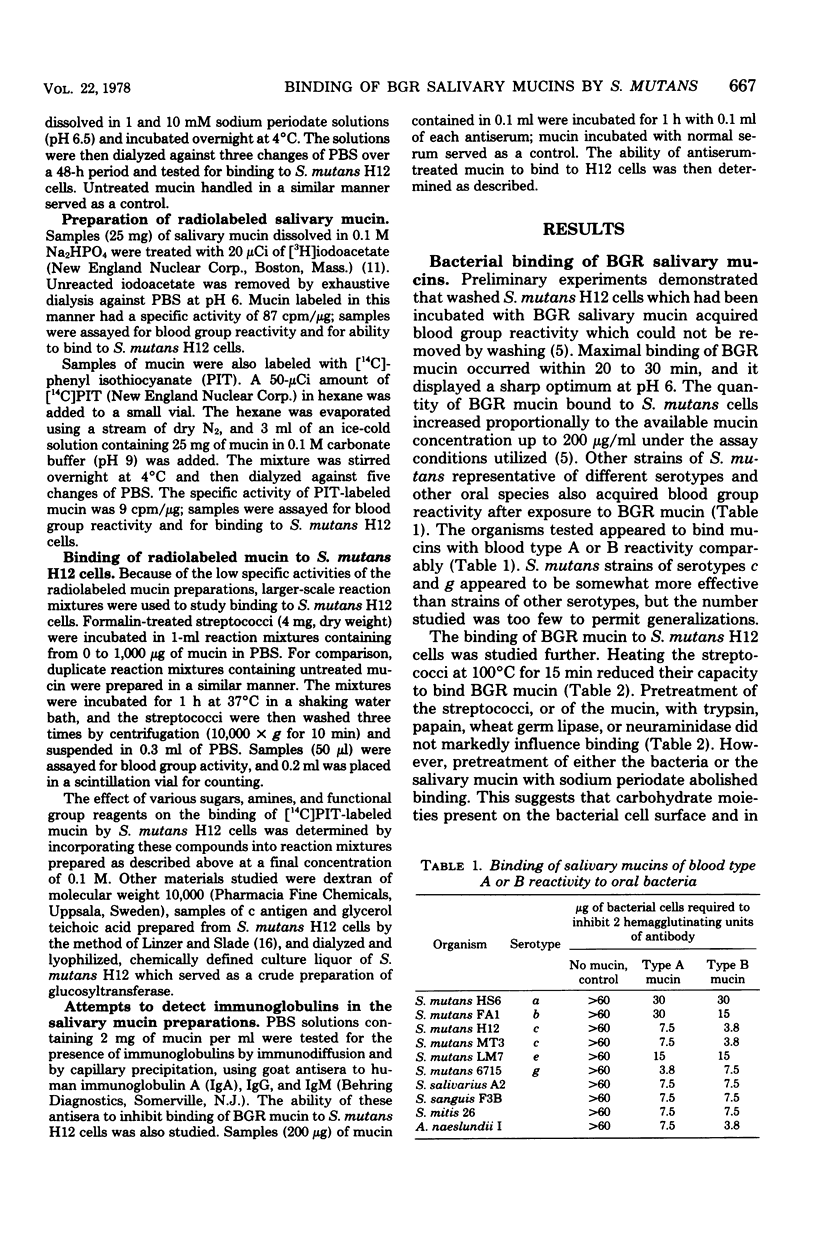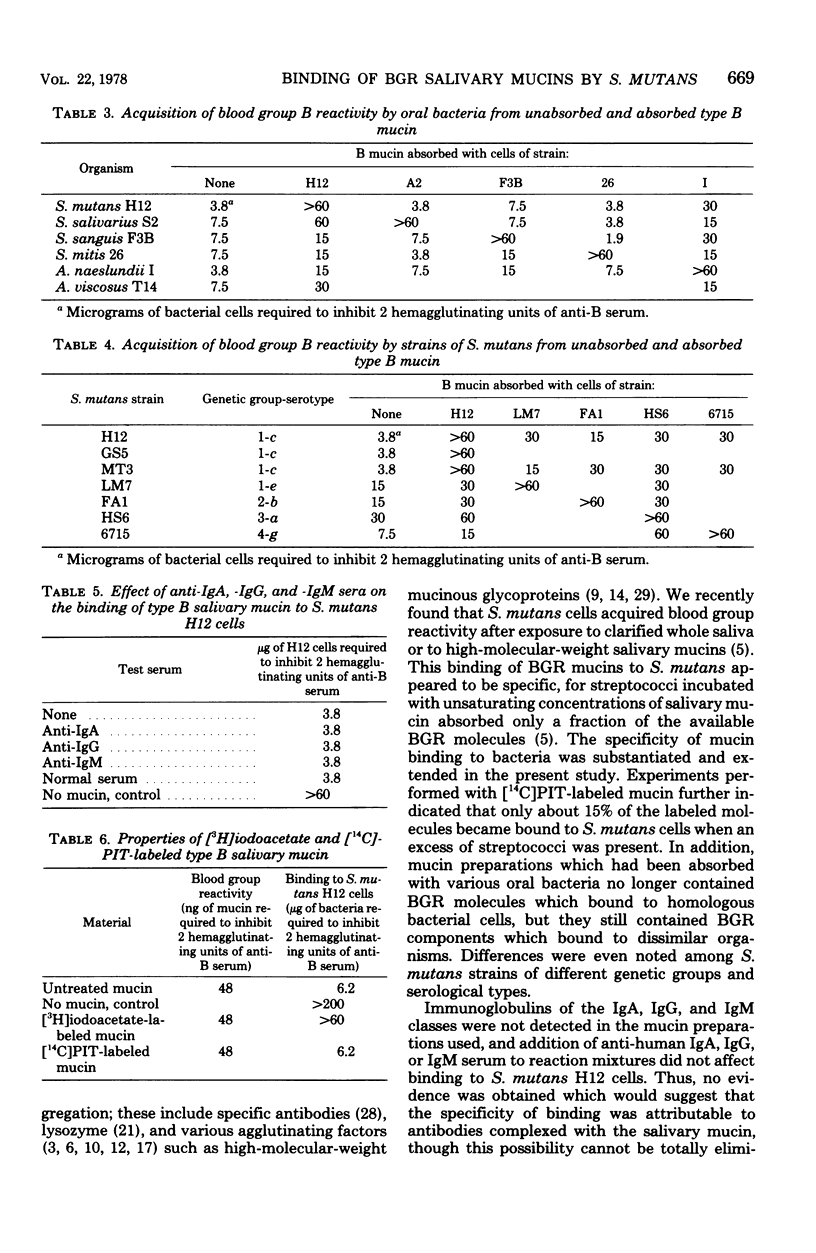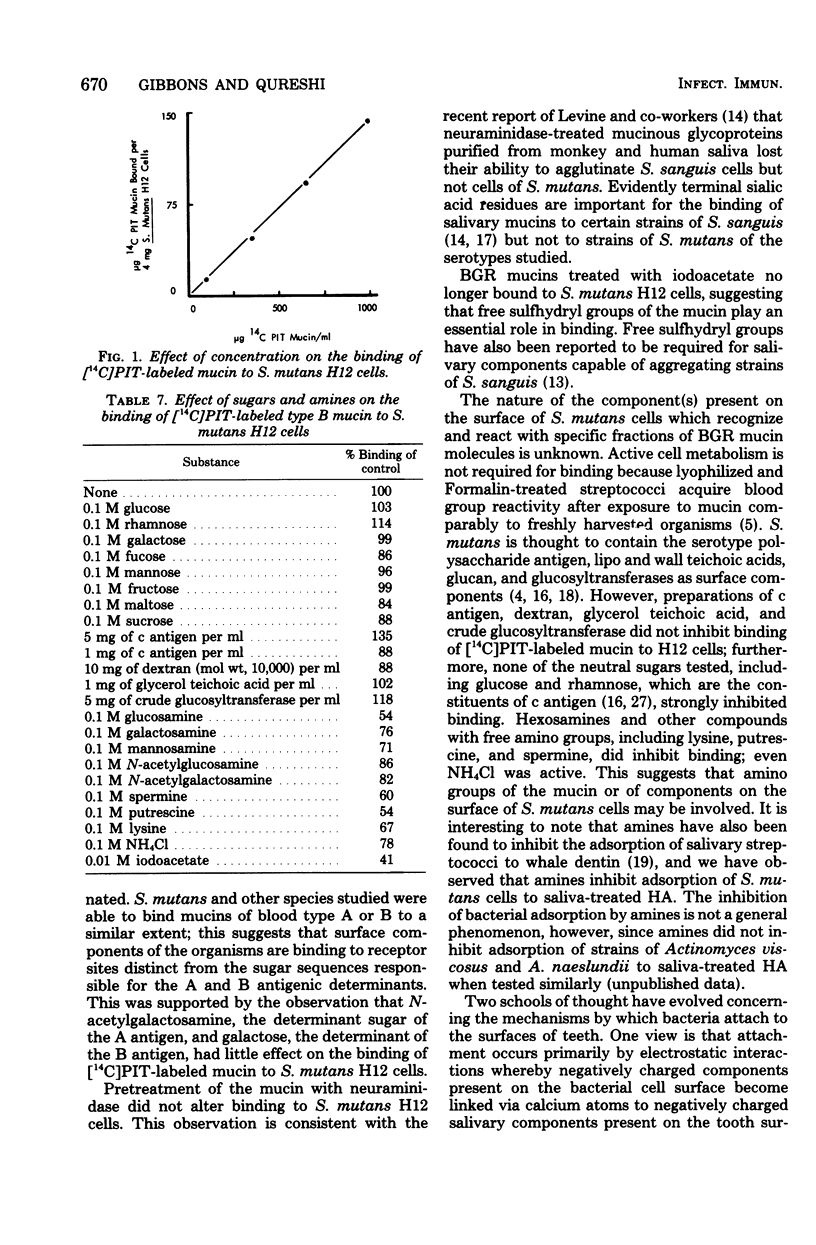Abstract
Strains of Streptococcus mutans of four genetic groups and five serotypes, and strains of S. sanguis, S. mitis, S. salivarius, Actinomyces naeslundii, and A. viscosus, were found to bind blood group-reactive (BGR) mucin isolated from whole human saliva. The bacteria studied bound mucins with blood type A or B reactivity to a similar extent, suggesting that the carbohydrate moieties responsible for the A and B antigenic determinants were not involved. The organisms studied appeared to bind different fractions of BGR mucin molecules because preparations absorbed with cells of a given oral species no longer contained BGR molecules which bound to homologous organisms but still possessed BGR components which bound to varying degrees to other bacteria. Differences were even noted among S. mutans strains belonging to different genetic groups and serological types. Immunoglobulins could not be detected in the mucin preparations, and addition of anti-human immunoglobulin A (IgA), IgG, or IgM serum to reaction mixtures did not affect binding. Mucin pretreated with periodate or iodoacetate no longer bound to S. mutans H12 cells, suggesting that carbohydrate moieties and sulfhydryl groups played an essential role. Active cell metabolism was not required for BGR mucin binding; however, pretreatment of H12 cells with periodate or heat (100°C for 15 min) reduced binding. Mucin labeled with [14C]phenyl isothiocyanate appeared to bind to S. mutans H12 cells comparably to untreated mucin; the binding also appeared to be specific because less than 15% of the labeled material became bound when incubated with an excess of streptococci. Binding of [14C]phenyl isothiocyanate-labeled mucin was not affected by neutral sugars tested or by preparations of c antigen, glycerol teichoic acid, dextran, or crude glucosyltransferase. However, binding was inhibited by several amines. BGR salivary mucins are present in the acquired pellicle covering teeth; the ability of bacteria to selectively bind such components suggest that they may serve as receptor molecules involved in the attachment of bacteria to teeth.
Full text
PDF






Selected References
These references are in PubMed. This may not be the complete list of references from this article.
- Clark W. B., Bammann L. L., Gibbons R. J. Comparative estimates of bacterial affinities and adsorption sites on hydroxyapatite surfaces. Infect Immun. 1978 Mar;19(3):846–853. doi: 10.1128/iai.19.3.846-853.1978. [DOI] [PMC free article] [PubMed] [Google Scholar]
- Ericson T., Magnusson I. Affinity for hydroxyapatite of salivary substances inducing aggregation of oral streptococci. Caries Res. 1976;10(1):8–18. doi: 10.1159/000260185. [DOI] [PubMed] [Google Scholar]
- Ericson T. Salivary glycoproteins. Composition and adsorption to hydroxylapatite in relation to the formation of dental pellicles and calculus. Acta Odontol Scand. 1968 May;26(1):3–21. doi: 10.3109/00016356809004577. [DOI] [PubMed] [Google Scholar]
- Germaine G. R., Chludzinski A. M., Schachtele C. F. Streptococcus mutans dextransucrase: requirement for primer dextran. J Bacteriol. 1974 Oct;120(1):287–294. doi: 10.1128/jb.120.1.287-294.1974. [DOI] [PMC free article] [PubMed] [Google Scholar]
- Gibbons R. J., Houte J. V. Bacterial adherence in oral microbial ecology. Annu Rev Microbiol. 1975;29:19–44. doi: 10.1146/annurev.mi.29.100175.000315. [DOI] [PubMed] [Google Scholar]
- Gibbons R. J., van Houte J. On the formation of dental plaques. J Periodontol. 1973 Jun;44(6):347–360. doi: 10.1902/jop.1973.44.6.347. [DOI] [PubMed] [Google Scholar]
- Hay D. I., Gibbons R. J., Spinell D. M. Characteristics of some high molecular weight constituents with bacterial aggregating activity from whole saliva and dental plaque. Caries Res. 1971;5(2):111–123. doi: 10.1159/000259739. [DOI] [PubMed] [Google Scholar]
- Hillman J. D., Van Houte J., Gibbons R. J. Sorption of bacteria to human enamel powder. Arch Oral Biol. 1970 Sep;15(9):899–903. doi: 10.1016/0003-9969(70)90163-9. [DOI] [PubMed] [Google Scholar]
- Kalmakoff J., Parkinson A. J. Labeling of antibodies with 3H-acetate. Appl Microbiol. 1973 Oct;26(4):624–626. doi: 10.1128/am.26.4.624-626.1973. [DOI] [PMC free article] [PubMed] [Google Scholar]
- Kashket S., Donaldson C. G. Saliva-induced aggregation of oral streptococci. J Bacteriol. 1972 Dec;112(3):1127–1133. doi: 10.1128/jb.112.3.1127-1133.1972. [DOI] [PMC free article] [PubMed] [Google Scholar]
- Kashket S., Hankin S. R. Interaction of streptococcal aggregating factors with thiol-and disulphide-reactive compounds. Arch Oral Biol. 1977;22(1):49–53. doi: 10.1016/0003-9969(77)90139-x. [DOI] [PubMed] [Google Scholar]
- Levine M. J., Herzberg M. C., Levine M. S., Ellison S. A., Stinson M. W., Li H. C., van Dyke T. Specificity of salivary-bacterial interactions: role of terminal sialic acid residues in the interaction of salivary glycoproteins with Streptococcus sanguis and Streptococcus mutans. Infect Immun. 1978 Jan;19(1):107–115. doi: 10.1128/iai.19.1.107-115.1978. [DOI] [PMC free article] [PubMed] [Google Scholar]
- Liljemark W. F., Schauer S. V. Studies on the bacterial components which bind Streptococcus sanguis and Streptococcus mutans to hydroxyapatite. Arch Oral Biol. 1975 Sep;20(9):609–615. doi: 10.1016/0003-9969(75)90082-5. [DOI] [PubMed] [Google Scholar]
- Linzer R., Gill K., Slade H. D. Chemical composition of Streptococcus mutans type c antigen: comparison to type a, b, and d antigens. J Dent Res. 1976 Jan;55:A109–A115. doi: 10.1177/002203457605500103011. [DOI] [PubMed] [Google Scholar]
- Magnusson I., Ericson T. Effect of salivary agglutinins of reactions between hydroxyapatite and a serotype c strain of Streptococcus mutans. Caries Res. 1976;10(4):273–286. doi: 10.1159/000260208. [DOI] [PubMed] [Google Scholar]
- McBride B. C., Gisslow M. T. Role of sialic acid in saliva-induced aggregation of Streptococcus sanguis. Infect Immun. 1977 Oct;18(1):35–40. doi: 10.1128/iai.18.1.35-40.1977. [DOI] [PMC free article] [PubMed] [Google Scholar]
- Olsson J., Odham G. Effect of inorganic ions and surface active organic compounds on the adherence of oral streptococci. Scand J Dent Res. 1978 Mar;86(2):108–117. doi: 10.1111/j.1600-0722.1978.tb00615.x. [DOI] [PubMed] [Google Scholar]
- Orstavik D., Kraus F. W., Henshaw L. C. In vitro attachment of streptococci to the tooth surface. Infect Immun. 1974 May;9(5):794–800. doi: 10.1128/iai.9.5.794-800.1974. [DOI] [PMC free article] [PubMed] [Google Scholar]
- Rölla G. Effects of fluoride on initiation of plaque formation. Caries Res. 1977;11 (Suppl 1):243–261. doi: 10.1159/000260303. [DOI] [PubMed] [Google Scholar]
- Rölla G. Formation of dental integuments--some basic chemical considerations. Swed Dent J. 1977;1(6):241–251. [PubMed] [Google Scholar]
- Sönju T., Christensen T. B., Kornstad L., Rölla G. Electron microscopy, carbohydrate analyses and biological activities of the proteins adsorbed in two hours to tooth surfaces in vivo. Caries Res. 1974;8(2):113–122. doi: 10.1159/000260099. [DOI] [PubMed] [Google Scholar]
- Sönju T., Rölla G. Chemical analysis of the acquired pellicle formed in two hours on cleaned human teeth in vivo. Rate of formation and amino acid analysis. Caries Res. 1973;7(1):30–38. doi: 10.1159/000259822. [DOI] [PubMed] [Google Scholar]
- Wetherell J. R., Jr, Bleiweis A. S. Antigens of Streptococcus mutans: characterization of a polysaccharide antigen from walls of strain GS-5. Infect Immun. 1975 Dec;12(6):1341–1348. doi: 10.1128/iai.12.6.1341-1348.1975. [DOI] [PMC free article] [PubMed] [Google Scholar]
- Williams R. C., Gibbons R. J. Inhibition of bacterial adherence by secretory immunoglobulin A: a mechanism of antigen disposal. Science. 1972 Aug 25;177(4050):697–699. doi: 10.1126/science.177.4050.697. [DOI] [PubMed] [Google Scholar]
- Williams R. C., Gibbons R. J. Inhibition of streptococcal attachment to receptors on human buccal epithelial cells by antigenically similar salivary glycoproteins. Infect Immun. 1975 Apr;11(4):711–718. doi: 10.1128/iai.11.4.711-718.1975. [DOI] [PMC free article] [PubMed] [Google Scholar]


